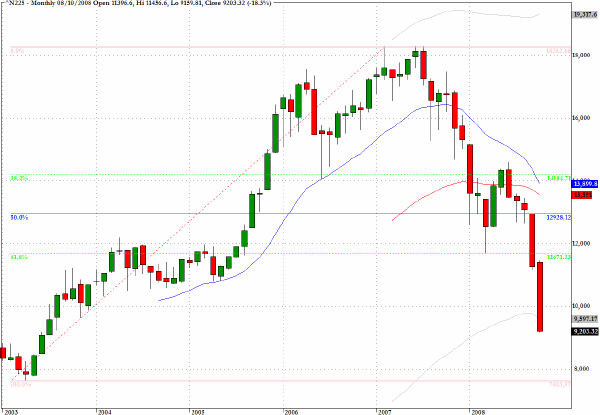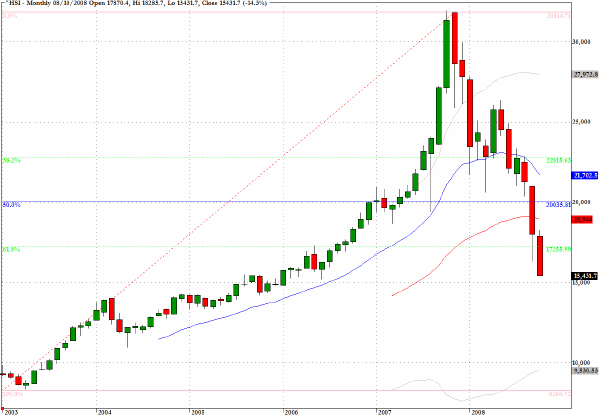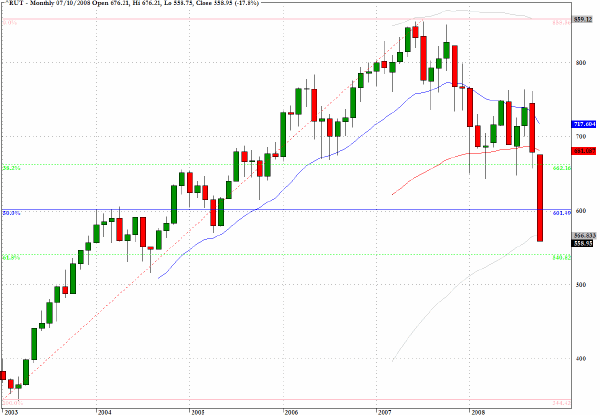| Corcoran Technical Trading Patterns For October 8 |
| By Clive Corcoran |
Published
10/8/2008
|
Stocks
|
Unrated
|
|
|
|
Corcoran Technical Trading Patterns For October 8
Politicians and central bankers are increasingly looking very well suited to their roles that bear a striking resemblance to the unfortunate deckchair attendants on the Titanic.
The wealth destruction that is currently taking place is mind-numbing. Despite the fact that there are currently excellent opportunities for one way short bets across a whole spectrum of exchange traded funds for those that are nimble, one has to be genuinely concerned for the future well being of those who are not sophisticated in the ways of modern markets, which applies to the great majority of ordinary folks.
The spiral of asset deflation and value devastation will have very ugly consequences. Pension funds are being decimated, bank depositors are running scared and even sovereign risk has to be considered seriously. Most alarming is the growing breakdown of trust in the institutional framework which is far more worrying than a loss of confidence.
Average citizens who may have been taught more physics and chemistry than will ever be useful in their lives can go right through secondary and university education with absolutely no exposure to how the fractional reserve banking system should work and how securitization has transformed the capital markets over the last twenty years.
No wonder that they find the current maelstrom to be a sign that those they trusted to lead and govern prudently cannot be trusted to fix the system. While politicians keep rattling on about how they will do everything to ensure the stability of the system, this is not calming the fear of average citizens as it comes from the same mouths of those leaders who were unable to put in place a properly framed 21st century financial regulatory structure. Increasing numbers are now waking up to the fact that large sections of the financial system are not simply suffering from a liquidity crisis, but are actually insolvent.
The most bizarre aspect to the whole episode is that the innuendo and undercurrent of stated policy seems to be - how can we get people to go out and borrow more money to stave off a crisis caused by excessive leverage against scarce real capital?
We may find that the only solution to this crisis is some form of Debt Amnesty in which all consumers, businesses as well as the hapless bankers will be allowed to re-structure their finances with perhaps 50 cents on the dollar write-downs of debts.
The Nikkei 225 plunged almost ten percent in overnight trading and, the monthly chart vividly reveals, as discussed here last week, how a test of the 2003 lows could be only a few sessions away.

Despite an interest rate cut the Hang Seng index (^HSI) dropped more than 1300 points and is only 400 points from the 15000 target that I suggested, hesitatingly, in yesterday's column. The monthly chart shows how we have clearly taken out the 62% retracement of the 2003/7 bull move and in starker terms how this market has lost more than half its value in less than a year.

In recent days the behavior of the Russell 2000 (^RUT) is now finally pointing to the fact that asset managers have gone beyond denial of the severity of the current crisis, to a much more realistically bearish view of the economic outlook.
For a long time the relative strength of small cap stocks suggested that while fund managers were talking about recessions, liquidity crises etc. they were still behaving in a basically bullish manner. Their "faith" in the small caps could perhaps be traced back to the great leadership provided by the Russell 2000 as we emerged from the 2001/2 Nasdaq implosion.
Rather than looking for a capitulation in the DJIA, which many commentators mistakenly suggested happened in Monday's session, I would respectfully suggest that the economic/industrial meltdown, which is now being ushered in by the aftermath of the total mismanagement of the banking system, will probably manifest itself when small cap stocks are trashed again.

Clive Corcoran is the publisher of TradeWithForm.com, which provides daily analysis and commentary on the US stock market. He specializes in market neutral investing and and is currently working on a book about the benefits of trading with long/short strategies, which is scheduled for publication later this year.
Disclaimer
The purpose of this article is to offer you the chance to review the trading methodology, risk reduction strategies and portfolio construction techniques described at tradewithform.com. There is no guarantee that the trading strategies advocated will be profitable. Moreover, there is a risk that following these strategies will lead to loss of capital. Past results are no guarantee of future results. Trading stocks and CFD's can yield large rewards, but also has large potential risks. Trading with leverage can be especially risky. You should be fully aware of the risks of trading in the capital markets. You are strongly advised not to trade with capital.
|